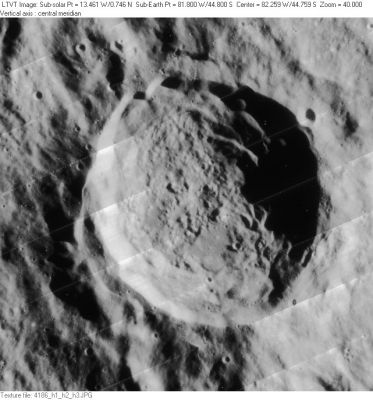Difference between revisions of "Baade"
| Line 1: | Line 1: | ||
<div id="content_view" class="wiki" style="display: block"> | <div id="content_view" class="wiki" style="display: block"> | ||
=Baade= | =Baade= | ||
| − | ''(formerly '''[ | + | ''(formerly '''[[Inghirami|Inghirami]] D''')''<br /> |
{| class="wiki_table" | {| class="wiki_table" | ||
| | | | ||
| − | Lat: 44.8°S, Long: 81.8°W, Diam: 55 km, Depth: 5.24 km, [ | + | Lat: 44.8°S, Long: 81.8°W, Diam: 55 km, Depth: 5.24 km, [[R%C3%BCkl%2061|Rükl: 61]]<br /> |
|} | |} | ||
<div id="toc"> | <div id="toc"> | ||
| Line 12: | Line 12: | ||
[http://www.lpod.org/coppermine/thumbnails.php?album=search&type=full&search=Baade LPOD Photo Gallery] [http://www.lpi.usra.edu/resources/lunar_orbiter/bin/srch_nam.shtml?Baade%7C0 Lunar Orbiter Images] [http://www.lpi.usra.edu/resources/apollo/search/feature/?feature=Baade Apollo Images]<br /> <br /> | [http://www.lpod.org/coppermine/thumbnails.php?album=search&type=full&search=Baade LPOD Photo Gallery] [http://www.lpi.usra.edu/resources/lunar_orbiter/bin/srch_nam.shtml?Baade%7C0 Lunar Orbiter Images] [http://www.lpi.usra.edu/resources/apollo/search/feature/?feature=Baade Apollo Images]<br /> <br /> | ||
==Maps== | ==Maps== | ||
| − | ''([ | + | ''([[LAC%20zone|LAC zone]] 109D4)'' [http://planetarynames.wr.usgs.gov/images/Lunar/lac_109.pdf USGS Digital Atlas PDF]<br /> <br /> |
==Description== | ==Description== | ||
<br /> | <br /> | ||
| Line 18: | Line 18: | ||
[http://en.wikipedia.org/wiki/Baade_(crater) Baade]<br /> <br /> | [http://en.wikipedia.org/wiki/Baade_(crater) Baade]<br /> <br /> | ||
==Additional Information== | ==Additional Information== | ||
| − | Depth data from [ | + | Depth data from [[Kurt%20Fisher%20crater%20depths|Kurt Fisher database]]<br /> |
* Westfall, 2000: 5.24 km | * Westfall, 2000: 5.24 km | ||
<br /> | <br /> | ||
| Line 24: | Line 24: | ||
* Named for [http://en.wikipedia.org/wiki/Walter_Baade Wilhelm Heinrich Walter Baade] (March 24, 1893–June 25, 1960), a German astronomer who emigrated to the USA in 1931. He took advantage of wartime blackout conditions during World War II, which reduced light pollution at Mount Wilson Observatory, to resolve stars in the center of the Andromeda galaxy for the first time, which led him to define distinct "populations" for stars. He discovered that there are two types of Cepheid variable stars, identified the optical counterparts of various radio sources and discovered 10 asteroids. | * Named for [http://en.wikipedia.org/wiki/Walter_Baade Wilhelm Heinrich Walter Baade] (March 24, 1893–June 25, 1960), a German astronomer who emigrated to the USA in 1931. He took advantage of wartime blackout conditions during World War II, which reduced light pollution at Mount Wilson Observatory, to resolve stars in the center of the Andromeda galaxy for the first time, which led him to define distinct "populations" for stars. He discovered that there are two types of Cepheid variable stars, identified the optical counterparts of various radio sources and discovered 10 asteroids. | ||
| − | * Called '''[ | + | * Called '''[[Inghirami|Inghirami]] D''' (Catalog number 2251) in the original [[IAU%20nomenclature|IAU nomenclature]] of [[Blagg%20and%20M%C3%BCller|Blagg and Müller]] (1935), where the name is attributed to [[Beer%20and%20M%C3%A4dler|Beer and Mädler]]. It was also apparently called '''Asaph [[Hall|Hall]]''' by Franz. |
| − | * The replacement name '''Baade''' was proposed by Arthur and Whitaker in their ''[ | + | * The replacement name '''Baade''' was proposed by Arthur and Whitaker in their ''[[Rectified%20Lunar%20Atlas|Rectified Lunar Atlas]]'' (1963) and approved by the IAU in [http://the-moon.us/wiki/IAU%20Transactions%20XIIB 1964]. |
<br /> <br /> | <br /> <br /> | ||
==LPOD Articles== | ==LPOD Articles== | ||
Revision as of 14:40, 15 April 2018
Contents
Baade
(formerly Inghirami D)
|
Lat: 44.8°S, Long: 81.8°W, Diam: 55 km, Depth: 5.24 km, Rükl: 61 |
Table of Contents
[#Baade Baade]
[#Baade-Images Images]
[#Baade-Maps Maps]
[#Baade-Description Description]
[#Baade-Description: Wikipedia Description: Wikipedia]
[#Baade-Additional Information Additional Information]
[#Baade-Nomenclature Nomenclature]
[#Baade-LPOD Articles LPOD Articles]
[#Baade-Bibliography Bibliography]
[#Baade-W. Baade in the Sourcebook Project (William R. Corliss) W. Baade in the Sourcebook Project (William R. Corliss)]

LO-IV-186H_LTVT
Images
LPOD Photo Gallery Lunar Orbiter Images Apollo Images
Maps
(LAC zone 109D4) USGS Digital Atlas PDF
Description
Description: Wikipedia
Additional Information
Depth data from Kurt Fisher database
- Westfall, 2000: 5.24 km
Nomenclature
- Named for Wilhelm Heinrich Walter Baade (March 24, 1893–June 25, 1960), a German astronomer who emigrated to the USA in 1931. He took advantage of wartime blackout conditions during World War II, which reduced light pollution at Mount Wilson Observatory, to resolve stars in the center of the Andromeda galaxy for the first time, which led him to define distinct "populations" for stars. He discovered that there are two types of Cepheid variable stars, identified the optical counterparts of various radio sources and discovered 10 asteroids.
- Called Inghirami D (Catalog number 2251) in the original IAU nomenclature of Blagg and Müller (1935), where the name is attributed to Beer and Mädler. It was also apparently called Asaph Hall by Franz.
- The replacement name Baade was proposed by Arthur and Whitaker in their Rectified Lunar Atlas (1963) and approved by the IAU in 1964.
LPOD Articles
Bibliography
W. Baade in the Sourcebook Project (William R. Corliss)
- In Mysterious Universe, a handbook of astronomical anomalies (1979) :
- Pages 604-605: Lightning, Novae, and Quasars (C.E.R.Bruce, Nature, 1966).
This page has been edited 1 times. The last modification was made by - tychocrater tychocrater on Jun 13, 2009 3:24 pm - afx3u2